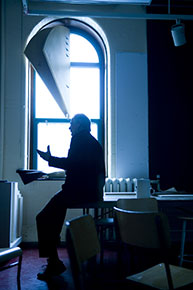At play in the world of forms
At one point during an early-afternoon lecture in the MacDonald-Harrington Building recently, architecture professor Pieter Sijpkes was explaining to the 30 or so students present the significant structural advantages of double-curved surfaces over flat surfaces.

Prof. Pieter Sijpkes investigates the possibility of using robots to build structures out of ice.
Claudio Calligaris
A few slides later, he was extolling the charms of an ice castle.
Leaping from engineering physics to winter forts might cause even the nimblest lecturer to stumble. But Prof. Sijpkes, who has taught in McGill's School of Architecture for 30 years, made the segue with the ease of someone who figured out long ago how to balance a fascination with structure and a flair for free play.
"Structure is what I like best," said Prof. Sijpkes, who was drawn to Montreal from his native Holland by the excitement of Expo '67 at the age of 22. "Whether they're physical structures or social structures, whether it's [the molecular form] of ice, sea water and clouds or riots in Harlem or an event like Expo '67. An architect's job is to mediate between social structures and physical ones."
In his efforts to understand the shape of things, both architectural and social, Prof. Sijpkes draws on what is clearly an active intellectual imagination. "Research is a bit like play. You have to say, 'that might be interesting, let's try it,'" he said.
His latest research project, for which he received $173,000 from the Social Sciences and Humanities Research Council in February, puts that philosophy into practice. Working with engineering professor Jorge Angeles from the Centre for Intelligent Machines, Prof. Sijpkes will spend the next three years exploring the possibility of using robots to make small-scale industrial prototypes and large-scale buildings out of a most unlikely material—ice.
One outcome of this unusual research could be a robotic cherry picker capable of constructing ice dwellings rapidly and at low cost, Prof. Sijpkes said. Such a robot might build up ice walls one layer at a time by tracking and craning in three dimensions, all the while dispensing, by way of a specially-designed nozzle, water mixed with something to help it freeze in place. Of course, in climates without year-round sub-zero temperatures, the resulting structures would eventually melt, so the technology's most likely short-term uses would come in the tourism and recreation industries, where it would serve as a fast, efficient means of erecting ice hotels, castles and sculptures, for example.
It might also allow for easy and fast construction of dwellings in warmer climates, with a material like adobe, or any number of other architectural applications, he said. "The ice is incidental, in a sense, because it's new thinking that we're really after. I hope we find something we hadn't even thought of."

